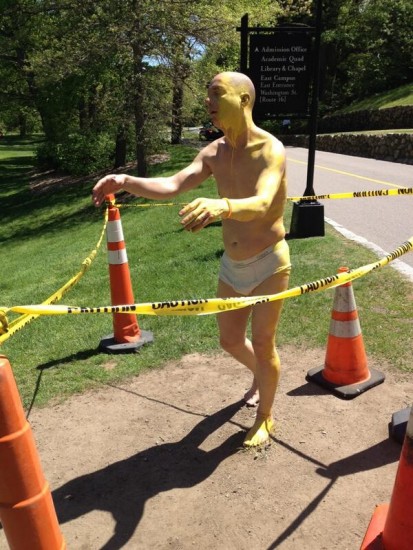
Tony Matelli’s “Sleepwalker” sculpture at Wellesley became a crime scene when vandals struck
Marlborough Chelsea
545 West 21st St. between Tenth & Eleventh Aves.
Tuesday – Saturday through August 8, 10:00 am – 6:00 pm
212-463-8634
www.marlboroughchelsea.com
www.wellesley.edu/davismuseum
Several weekends ago, after coming home from a jaunt through Chelsea galleries, I showed my wife photos I’d taken of some of my favorite works. Upon seeing one of them, she immediately said, “I think that’s the same piece that caused such a furor at Wellesley.” Indeed, I had shown her a photo of Tony Matelli’s “Sleepwalker,” a life-size painted bronze sculpture of a zombielike middle-aged white man in his underwear, eyes closed, arms outstretched, standing on the outdoor deck of the Marlborough Gallery on West 21st St. Being a sucker for lifelike sculpture — I can spend hours checking out works by Ron Mueck, Paul McCarthy, Mark Jenkins, and others — I got a huge kick out of the piece, which I found intriguing and humorous, not threatening at all, perhaps even symbolic of an America that often seems to be half asleep. However, context is everything. My wife quickly pointed out that a significant number of Wellesley students were aghast when a fiberglass cast of “Sleepwalker” had been placed outside, on campus, in February as part of the “Tony Matelli: New Gravity” exhibition at the university’s outstanding Davis Museum, the Chicago-born, Brooklyn-based sculptor’s first solo museum show. Coincidentally, we were going to Wellesley the following weekend, where we looked forward to seeing the sculpture for ourselves in an environment very different from the Chelsea deck, but sadly it had had to be removed in May, ahead of the July 20 conclusion of the exhibition, for a very surprising reason.
Shortly after the unveiling of “Sleepwalker,” which was placed outside in a wooded area near the Davis, where it could be seen from a window, hundreds of Wellesley students signed an online petition calling for the work to be moved inside the museum. The petition read in part, “Within just a few hours of its outdoor installation, the highly lifelike sculpture . . . has become a source of apprehension, fear, and triggering thoughts regarding sexual assault for some members of our campus community. While it may appear humorous, or thought provoking to some, the ‘Sleepwalker’ has already become a source of undue stress for a number of Wellesley College students, the majority of whom live, study, and work on campus.” Davis Museum director Lisa Fischman defended the installation, explaining, “Art has an extraordinary power to evoke personal response, and to elicit the unexpected. . . . Art provokes dialogue, and discourse is the core of education. In that spirit, I am enormously glad to have your response.”
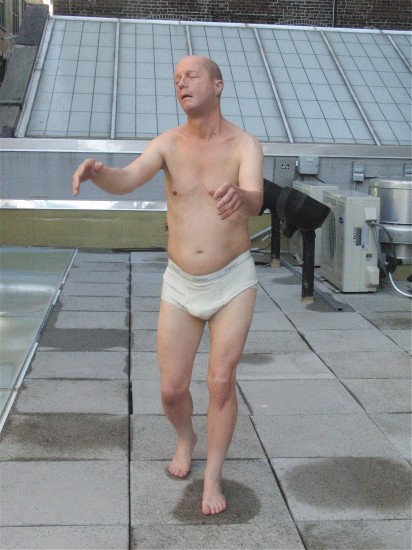
“Sleepwalker” will stay up at the Marlborough Chelsea through August 8 (photo by twi-ny/mdr)
Matelli himself chimed in on the debate, telling CBS Boston, “I think that these people are misconstruing this work. I think they’re seeing something in this work that isn’t there. But who am I to say how people should react to this?” He added, “I don’t think they’ll take the statue down. But if they make that decision, that’s fine with me.” I’m not sure it’s fine with Matelli why it ultimately had to be taken down; first, a student (since suspended) spray-painted the statue yellow, her class color (she did the same to Matelli’s nearby small dog sculpture), then a still-unidentified perp broke the five-foot, nine-inch-high “Sleepwalker” at its ankles, apparently in an effort to kick it down. I was shocked when I saw photos of the damage, which totaled the work, leaving it irreparable; was this really possible at such a liberal, free-thinking college as Wellesley? Is this type of censorship any different from Attorney General John Ashcroft and deputy director of public affairs Monica Goodling using a blue curtain to cover up the partially nude “Spirit of Justice” Art Deco aluminum statue in the Great Hall of the Justice Department in 2002? Or when performance artist Alexander Brener spray-painted a green dollar sign over Kazimir Malevich’s “Suprematisme 1920-1927” in 1997 in protest of the commercialism of art? (“I view my act as a dialogue with Malevich,” Brener said in court.) During the Wellesley reunion weekend, I spoke with numerous current and former students of all ages, and each had an individual reaction to the installation of “Sleepwalker” itself and to the eventual damage. Some felt that art is art and people should “get a life” and not interpret everything so personally. Others believed it was a gross error on the part of the museum and the school to put a statue so suggestive to survivors or victims of sexual abuse outside, near a wooded area, at a woman’s college. Fortunately, no one was in favor of the vandalism. Yes, it’s encouraging that a work of art elicited such strong personal feelings on many fronts, but have we become a bunch of whimpering souls, not able to look the other way when it comes to an inanimate sculpture that means different things to different people? If something is displeasing to some but not to others, must it be wished away into the cornfield, hidden where no one will ever see it? Or is it further evidence that the gender divide is still much larger than we imagined, even at such an illustrious college as Wellesley? You can check out Matelli’s “Sleepwalker” at the Marlborough through August 8, but, of course, you’ll never be able to see the Wellesley version.
 Finally getting its North American premiere after being banned in its home country of China, Ning Hao’s No Man’s Land is a violently beautiful black comedy that takes on modernization and commercialization with tongue firmly and riotously rooted deep in cheek. Xu Zhen stars as Pan Xiao, a young hotshot lawyer, if he does say so himself, who gets a vicious falcon poacher (Duo Bujie) off for killing a cop. The poacher promises to wire Pan his fee, but the lawyer instead demands collateral in the form of the red car the poacher bought for his dead wife. Pan then sets out for home, riding across the Gobi desert in Xinjiang in northwest China, but things don’t go too well for him, as he keeps getting involved with strange, dangerous, ever-more-surreal men and women, from a pair of truck drivers transporting hay (Wang Shuangbao and Sun Jianmin) to an extortionist gas station owner (Yan Xinming) and his back-room prostitute (Yu Nan) to another falcon poacher (Huang Bo) who can’t avoid getting the crap beaten out of him time and time again. But Pan keeps trying to persevere, believing he is better than everyone around him, but it takes him quite a while to learn his lesson, if he ever really does.
Finally getting its North American premiere after being banned in its home country of China, Ning Hao’s No Man’s Land is a violently beautiful black comedy that takes on modernization and commercialization with tongue firmly and riotously rooted deep in cheek. Xu Zhen stars as Pan Xiao, a young hotshot lawyer, if he does say so himself, who gets a vicious falcon poacher (Duo Bujie) off for killing a cop. The poacher promises to wire Pan his fee, but the lawyer instead demands collateral in the form of the red car the poacher bought for his dead wife. Pan then sets out for home, riding across the Gobi desert in Xinjiang in northwest China, but things don’t go too well for him, as he keeps getting involved with strange, dangerous, ever-more-surreal men and women, from a pair of truck drivers transporting hay (Wang Shuangbao and Sun Jianmin) to an extortionist gas station owner (Yan Xinming) and his back-room prostitute (Yu Nan) to another falcon poacher (Huang Bo) who can’t avoid getting the crap beaten out of him time and time again. But Pan keeps trying to persevere, believing he is better than everyone around him, but it takes him quite a while to learn his lesson, if he ever really does.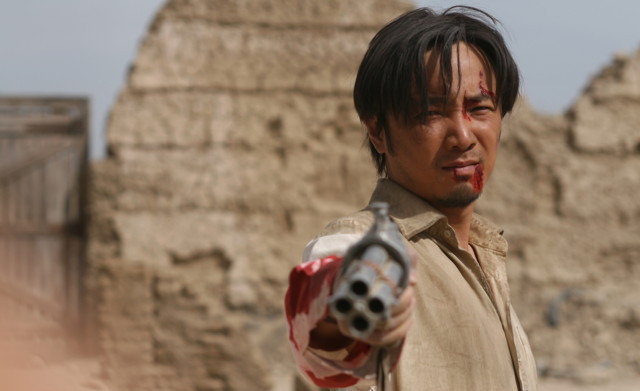
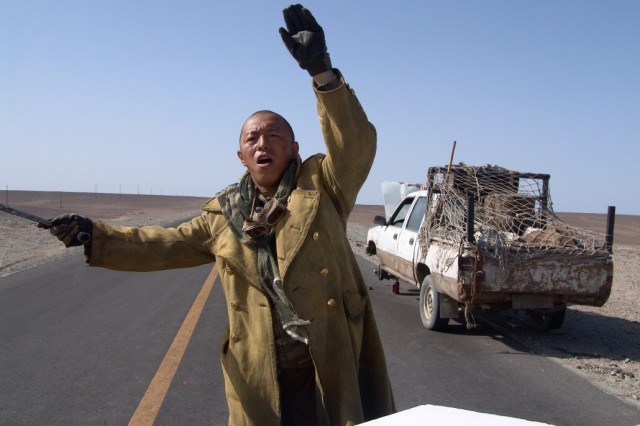
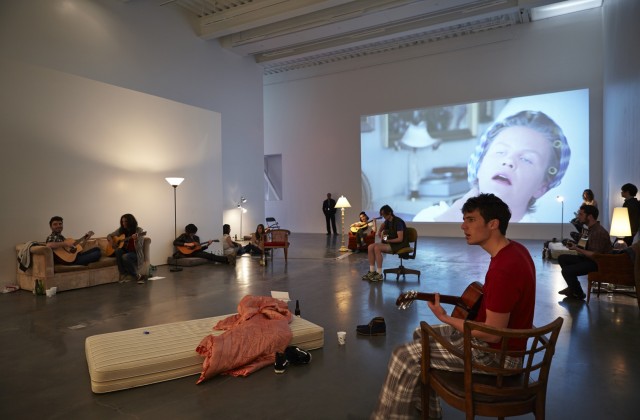
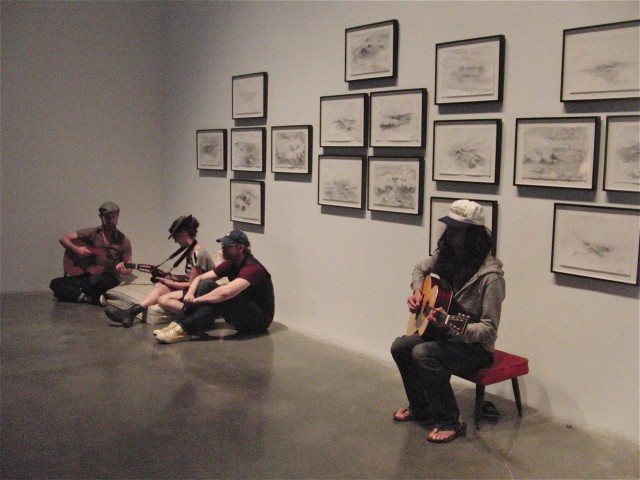

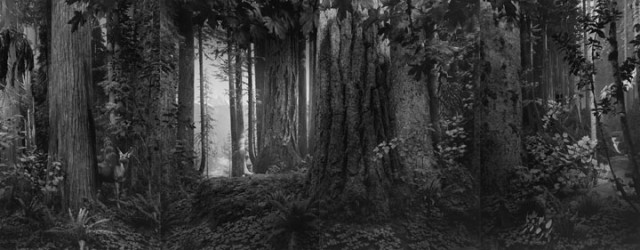
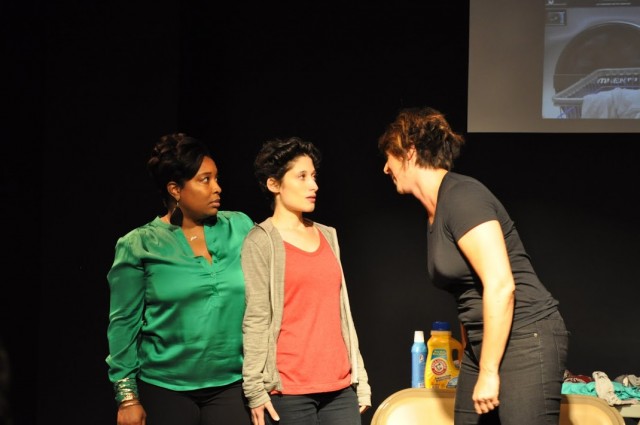
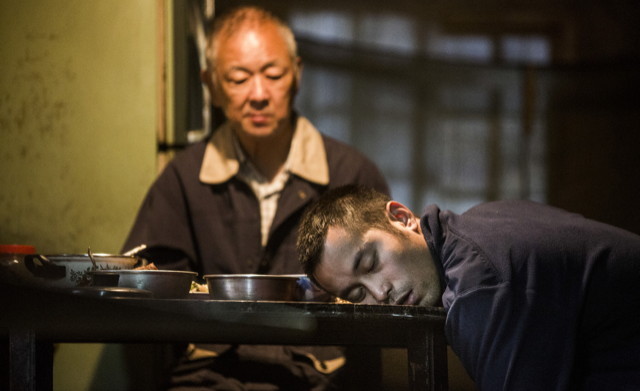
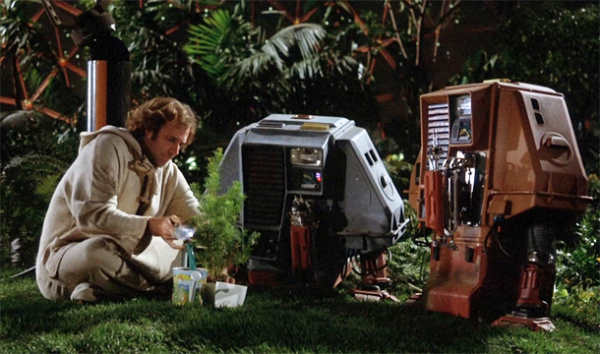
 Special effects master Douglas Trumbull, who worked on such sci-fi classics as 2001: A Space Odyssey, Close Encounters of the Third Kind, and Blade Runner, made his feature directorial debut with the environmentally prescient Silent Running. Bruce Dern stars as Freeman Lowell, one of four men stationed on the space terrarium Valley Forge, which is charged with protecting forests that can no longer grow on Earth. While it’s just another assignment for John Keenan (Cliff Potts), Marty Barker (Ron Rifkin), and Andy Wolf (Jesse Vint), it’s become an obsession for Lowell, who sleeps under a “Conservation Pledge” on the wall next to his bed and only eats food from his massive garden. But when the captain of the Berkshire (voiced by Joseph Campanella) informs them that the forests must be destroyed and they are to return home, Lowell takes matters into his own hands, fighting to protect what he has helped create. Soon he is alone on the Valley Forge, tending to the forest with drones Huey (Cheryl Sparks) and Dewey (Mark Persons), as Louie (Steven Brown) is no longer with them. At first Lowell thinks he is in his own private paradise, but extreme loneliness awaits him, along with some other shocks. Written by Deric Washburn and Michael Cimino (The Deer Hunter) and Steven Bochco (Hill Street Blues, L.A. Law), the low-budget Silent Running is a deserving cult classic, a worthy influence on such films and television shows as WALL-E, Moon, Mystery Science Theater 3000, and Red Dwarf. Emerging from the late-1960s Flower Power movement, the film’s ecological theme is boosted by environmentally friendly folk songs sung by Joan Baez, with overly melodramatic music by Peter Schickele. Dern gives a beautifully nuanced performance as Lowell, going from calm and meditative to distressed and angry in a heartbeat, and his paternal relationship with Huey and Dewey is both heartwarming and heartbreaking. A film that could only be made in the 1970s, with bright, bold colors and cheesy futuristic sets, Silent Running is screening June 28 at 7:00 as part of the Museum of the Moving Image’s “See It Big! Science Fiction (Part Two)” series, which continues through July 12 with such other sci-fi flicks as Alain Resnais’s Je T’Aime, Je T’Aime, Stanley Kubrick’s 2001: A Space Odyssey in 70mm, and Tim Burton’s Mars Attacks!
Special effects master Douglas Trumbull, who worked on such sci-fi classics as 2001: A Space Odyssey, Close Encounters of the Third Kind, and Blade Runner, made his feature directorial debut with the environmentally prescient Silent Running. Bruce Dern stars as Freeman Lowell, one of four men stationed on the space terrarium Valley Forge, which is charged with protecting forests that can no longer grow on Earth. While it’s just another assignment for John Keenan (Cliff Potts), Marty Barker (Ron Rifkin), and Andy Wolf (Jesse Vint), it’s become an obsession for Lowell, who sleeps under a “Conservation Pledge” on the wall next to his bed and only eats food from his massive garden. But when the captain of the Berkshire (voiced by Joseph Campanella) informs them that the forests must be destroyed and they are to return home, Lowell takes matters into his own hands, fighting to protect what he has helped create. Soon he is alone on the Valley Forge, tending to the forest with drones Huey (Cheryl Sparks) and Dewey (Mark Persons), as Louie (Steven Brown) is no longer with them. At first Lowell thinks he is in his own private paradise, but extreme loneliness awaits him, along with some other shocks. Written by Deric Washburn and Michael Cimino (The Deer Hunter) and Steven Bochco (Hill Street Blues, L.A. Law), the low-budget Silent Running is a deserving cult classic, a worthy influence on such films and television shows as WALL-E, Moon, Mystery Science Theater 3000, and Red Dwarf. Emerging from the late-1960s Flower Power movement, the film’s ecological theme is boosted by environmentally friendly folk songs sung by Joan Baez, with overly melodramatic music by Peter Schickele. Dern gives a beautifully nuanced performance as Lowell, going from calm and meditative to distressed and angry in a heartbeat, and his paternal relationship with Huey and Dewey is both heartwarming and heartbreaking. A film that could only be made in the 1970s, with bright, bold colors and cheesy futuristic sets, Silent Running is screening June 28 at 7:00 as part of the Museum of the Moving Image’s “See It Big! Science Fiction (Part Two)” series, which continues through July 12 with such other sci-fi flicks as Alain Resnais’s Je T’Aime, Je T’Aime, Stanley Kubrick’s 2001: A Space Odyssey in 70mm, and Tim Burton’s Mars Attacks!
